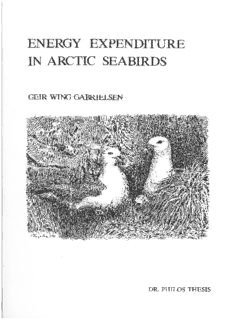
energy expenditure in arctic seabirds PDF
Preview energy expenditure in arctic seabirds
ENERGY EXPENDITURE IN ARCTIC SEABIRDS GEIR WING GABRIELSEN DR. PHILOS THESIS Norwegian Institute for Nature Research (NINA), Troms0, Norwegian Polar Institute (NP), Oslo and Department of Arctic Biology and Institute of Medical Biology, University of TromsB, Troms0, Norway ENERGY EXPENDITURE IN ARCTIC SEABIRDS 1 GEIR WING GABRIELSEN ISBN 82-7589-036-5 Printed ~n Nwway by Nordoifset, Tmrnrrr To Jorid, Sigrid, Endre and Ingrid CONTENTS PAGE ........................................ AC~OVJLEDGEMENTS 5 ................................................. PREFACE 7 ............................................ INTRODUCTION 9 ....... ................................. ~hemoregulation 12 ....... ................................. Aim of the study 14 .................... METABOLIC AND INSULATIVE ADAPTATIONS 15 ....... ........................... Resting metabolic rate 16 ....... ....................................... Insulation 28 ....... ................................. Body temperature 31 ............................ ENERGY COST OF REPRODUCTION 34 ....... ......................... Enery cost of incubation 36 ....... ..................... ~nergyc ost of chick rearing 41 ....... ................................. Chick energetics 54 ................................................. SUMMARY 60 .............................................. REFERENCES 63 PAPER I PAPER I1 PAPER I11 PAPER IV PAPER V PAPER VI PAPER VII This thesis is based upon data from laboratory and field studies on Svalbard and in northern Norway. Most of the laboratory work on Svalbard was done at the research station of the Norwegian Polar Institute in ~~-Alesun(d79 % 12OE), while the field studies were done in Kongsfjorden (7g0N 12OE), . in Hornsund (77% lSOE) and on Hopen Island (76 % 2S0E) Both the laboratory and field studies in northern Norway were carried out on Hornoya, an island in East Finnmark (70 % 31°E). Most of the work on which this thesis is based was done while I was a research fellow on the Norwegian Research Programme for Marine Arctic Ecology (PRO MARE) at the Norwegian Polar Institute in Oslo from 1984 to 1990. The final synopsis were written at the Norwegian Institute for Nature Research, Tromso, while working as a research fellow on the Programme on North Norwegian Coastal Ecology (MARE NOR) from 1990. I wish to thank Cand. real. Fridtjof Mehlum at the Norwegian Polar Institute who introduced me to Svalbard and seabird ecology. I also wish to thank Professor Johan B. Steen, at the University of Oslo, who introduced me to the fascinating world of animal physiology. Thanks also to Johan for his support, encouragement, enthusiasm and critical comments to my writing. These have been invaluable in the completion of this thesis. Thanks to Department of Arctic Biology and Prof. A.S. Blix for providing me with the opportunity to present my thesis to the University of Tromsa. I also wish to thank my friends and colleagues at both the Norwegian Polar Institute and at the Norwegian Institute for Nature Research in Tromss. I particularly thank Dr. Hans Erik Karlsen, Dr. Howard Parker, Dr. Marcel Klaassen, Dr. Jan R.E. Taylor, Dr. Marek Konarzewski, Cand. real Ian Gjertz and my students Per Fauchald and Espen Henriksen who took part in the collection of data as well as in the completion of included papers. Thanks to Dr. Kjell Einar Erikstad, NINA, Troms0, and Cand. real. Rob Barrett, Tromss Museum, for valuable discussions and critical comments on my writing. Thanks also to Ann-Grethe Bakker for secretarial assistance and to Viggo Ree for allowing me to use his seabird drawings. I also wish to thank the staffs of the research station of The Norwegian Polar Institute in ~y-Alesund,t he Polish Research Station in Hornsund and Hopen Radio for their assistance and accommodation during the field work. Finally I wish to thank my wife Jorid and our children (Sigrid, Endre and Ingrid) for all their support and patience during my many months away from home. This work was supported by The Research Council of Norway and The Norwegian Fisheries Research Council. LG/LL Geir Wing Gabrielsen This dissertation comprises studies on thermoregulation and energy expenditure in Arctic seabirds. It is based on the following papers which are referred to in the text by their Roman numerals: I. Gabrielsen, G.W., Mehlum, F., Karlsen, H.E., Andresen, 0. & H. Parker. 1991. Energy cost during incubation and thermoregulation in female Common Eider Somateria mollissima. Norsk Polarinstitutt Skrifter 195:51-62. 11. Gabrielsen, G.W., Mehlum, F. & K.A. Nagy 1987. Daily energy expenditure and energy utilization of free ranging Black-legged Kittiwakes. Condor 89:126-132. 111. Gabrielsen, G.W., Mehlum, F. & H.E. Karlsen 1988. Thermoregulation in four species of arctic seabirds. J. Comp. Physiol. B. 157:703<708. IV. Gabrielsen, G.W., Taylor, J.R.E., Konarzewski, M. & F. Mehlum 1991. Field and laboratory metabolism and thermoregulation in Dovekies (Alle alle). Auk 108:71-78. V. Konarzewski, M., Taylor, J.R.E. & G.W. Gabrielsen 1993. Energy requirements of Dovekie (Alle alle) chicks and their contribution to energy expenditure of adults. Auk 110:343-353. VI. Mehlum, F., Gabrielsen, G.W. & K.A. Nagy 1993. Energy expenditure by Black Guillemots (Cepphus grylle) during chick-rearing. Colonial Waterbirds 16:45-52. VII. Gabrielsen, G.W. 1994. Energy expenditure of breeding Common Guillemots. Can. Wild. Ser. Occ. Papers. (in press)
Description: